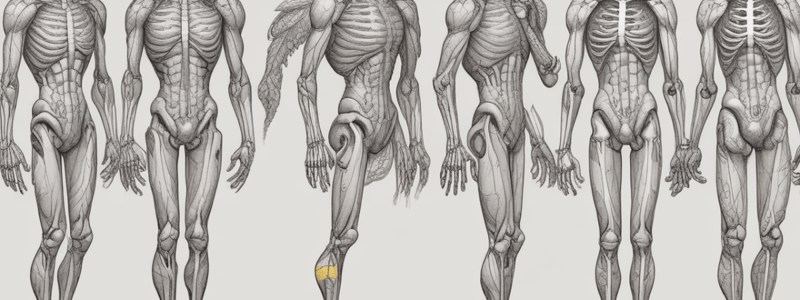Podcast
Questions and Answers
What is the primary reason for the differences between the upper and lower limb skeletons in humans?
What is the primary reason for the differences between the upper and lower limb skeletons in humans?
The primary reason is the shift from quadrupedalism to bipedalism, where the lower limbs bear the body weight and are responsible for locomotion, while the upper limbs are freed for other functions such as grasping and tool use.
What is the common feature shared by the proximal parts of both upper and lower limbs?
What is the common feature shared by the proximal parts of both upper and lower limbs?
The proximal parts of both upper and lower limbs are supported by a girdle of bones.
Compare the number of bones in the distal parts of the upper and lower limbs.
Compare the number of bones in the distal parts of the upper and lower limbs.
Both the distal parts of the upper and lower limbs contain two bones.
What is the function of the interosseous membrane in the upper and lower limbs?
What is the function of the interosseous membrane in the upper and lower limbs?
What is the significance of the multiple bones in the wrist and proximal foot?
What is the significance of the multiple bones in the wrist and proximal foot?
What is the name of the large bone in the proximal part of the upper limb?
What is the name of the large bone in the proximal part of the upper limb?
What is the evolutionary history that has contributed to the similarities and differences between the upper and lower limb skeletons?
What is the evolutionary history that has contributed to the similarities and differences between the upper and lower limb skeletons?
What is the name of the girdle that holds the lower limbs in place?
What is the name of the girdle that holds the lower limbs in place?
What is a key difference in the functional requirements of the upper and lower limb skeletons, and how does this impact their structure?
What is a key difference in the functional requirements of the upper and lower limb skeletons, and how does this impact their structure?
How do the joints of the upper and lower limbs differ in terms of mobility and stability?
How do the joints of the upper and lower limbs differ in terms of mobility and stability?
What is a key similarity between the feet and hands in terms of their skeletal structure?
What is a key similarity between the feet and hands in terms of their skeletal structure?
How does the proximal part of each limb contribute to its overall function?
How does the proximal part of each limb contribute to its overall function?
What is the significance of the distal part of each limb in terms of its skeletal structure?
What is the significance of the distal part of each limb in terms of its skeletal structure?
Why are the upper limb joints more prone to injury compared to the lower limb joints?
Why are the upper limb joints more prone to injury compared to the lower limb joints?
Flashcards are hidden until you start studying
Study Notes
The Upper and Lower Limbs: A Comparison
- Humans evolved from quadrupeds, with limbs designed to support body weight and facilitate movement, but became bipedal, freeing upper limbs for other functions like grasping objects and utilizing tools.
- Despite differences, upper and lower limb skeletons share common features due to evolutionary history.
Similarities Between Upper and Lower Limb Skeletons
- Proximal parts of both upper and lower limbs are supported by a girdle of bones (pectoral girdle for upper limbs, pelvic girdle for lower limbs).
- Each limb has one large bone at the proximal part (humerus in upper limb, femur in lower limb).
- Distal part of each limb contains two bones (radius and ulna in upper limb, tibia and fibula in lower limb) held apart by an interosseous membrane.
- Wrist and proximal foot contain multiple bones (carpal and tarsal bones, respectively) for a range of movement.
- Hands and feet have similar structures, with 5 metacarpals/metatarsals and 14 phalanges (bones of fingers and toes).
Functional Differences Between Upper and Lower Limb Skeletons
- Lower limb is weight-bearing and used for locomotion, resulting in reduced mobility at specific joints for greater stability.
- Upper limb is not weight-bearing, with relatively smaller and lighter bones, and more mobile joints to facilitate a range of activities.
- Greater mobility in upper limb joints increases the risk of injury, making joints like the shoulder more prone to injury.
Studying That Suits You
Use AI to generate personalized quizzes and flashcards to suit your learning preferences.




